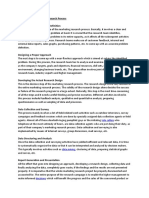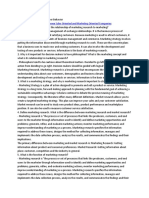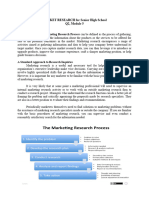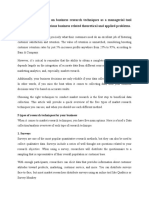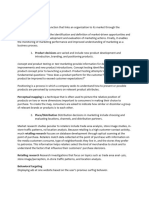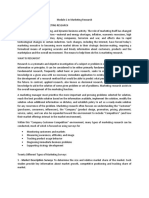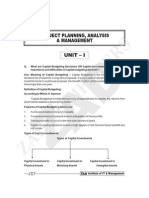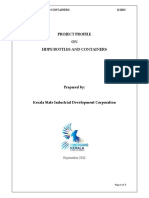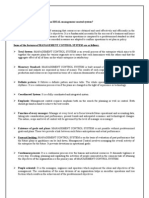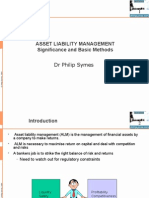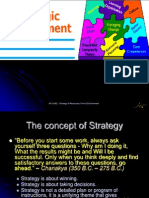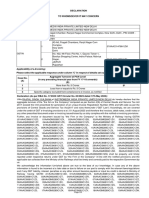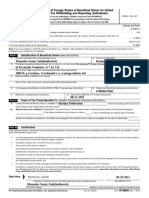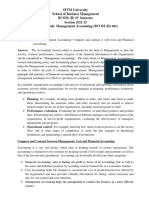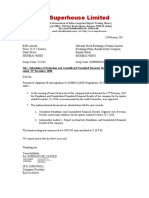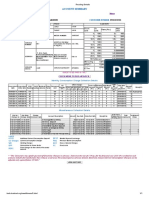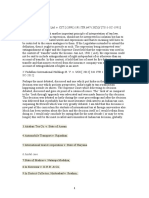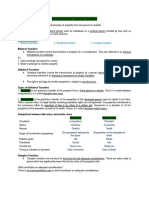0 ratings0% found this document useful (0 votes)
96 viewsMarket Analysis: Market Analysis Is The First Step of Project Analysis. It Simply Estimates The
Market Analysis: Market Analysis Is The First Step of Project Analysis. It Simply Estimates The
Uploaded by
Aamirx64Market analysis is the first step of project analysis and involves estimating the potential market size for a product or service. It examines aggregate demand and market share. The key steps in market analysis are: 1) defining the problem, 2) analyzing the situation through primary and secondary research, 3) obtaining specific data through qualitative and quantitative research, 4) analyzing and interpreting the data, 5) fostering ideas and problem solving based on results, and 6) creating a marketing plan. The objectives of market analysis are to understand customer needs and the competition in order to make informed marketing decisions.
Copyright:
© All Rights Reserved
Available Formats
Download as DOCX, PDF, TXT or read online from Scribd
Market Analysis: Market Analysis Is The First Step of Project Analysis. It Simply Estimates The
Market Analysis: Market Analysis Is The First Step of Project Analysis. It Simply Estimates The
Uploaded by
Aamirx640 ratings0% found this document useful (0 votes)
96 views10 pagesMarket analysis is the first step of project analysis and involves estimating the potential market size for a product or service. It examines aggregate demand and market share. The key steps in market analysis are: 1) defining the problem, 2) analyzing the situation through primary and secondary research, 3) obtaining specific data through qualitative and quantitative research, 4) analyzing and interpreting the data, 5) fostering ideas and problem solving based on results, and 6) creating a marketing plan. The objectives of market analysis are to understand customer needs and the competition in order to make informed marketing decisions.
Original Description:
Project Planning, Market Analysis
Original Title
Project Planning
Copyright
© © All Rights Reserved
Available Formats
DOCX, PDF, TXT or read online from Scribd
Share this document
Did you find this document useful?
Is this content inappropriate?
Market analysis is the first step of project analysis and involves estimating the potential market size for a product or service. It examines aggregate demand and market share. The key steps in market analysis are: 1) defining the problem, 2) analyzing the situation through primary and secondary research, 3) obtaining specific data through qualitative and quantitative research, 4) analyzing and interpreting the data, 5) fostering ideas and problem solving based on results, and 6) creating a marketing plan. The objectives of market analysis are to understand customer needs and the competition in order to make informed marketing decisions.
Copyright:
© All Rights Reserved
Available Formats
Download as DOCX, PDF, TXT or read online from Scribd
Download as docx, pdf, or txt
0 ratings0% found this document useful (0 votes)
96 views10 pagesMarket Analysis: Market Analysis Is The First Step of Project Analysis. It Simply Estimates The
Market Analysis: Market Analysis Is The First Step of Project Analysis. It Simply Estimates The
Uploaded by
Aamirx64Market analysis is the first step of project analysis and involves estimating the potential market size for a product or service. It examines aggregate demand and market share. The key steps in market analysis are: 1) defining the problem, 2) analyzing the situation through primary and secondary research, 3) obtaining specific data through qualitative and quantitative research, 4) analyzing and interpreting the data, 5) fostering ideas and problem solving based on results, and 6) creating a marketing plan. The objectives of market analysis are to understand customer needs and the competition in order to make informed marketing decisions.
Copyright:
© All Rights Reserved
Available Formats
Download as DOCX, PDF, TXT or read online from Scribd
Download as docx, pdf, or txt
You are on page 1of 10
Market Analysis: Market analysis is the first step of project analysis.
It simply estimates the
potential size of market for a product or a service. Market analysis is primarily concerned with
What would be the aggregate demand of the proposed product or service in the future?
What would be the market share of the project under appraisal?
So it becomes necessary that market analysis should be carried out in a careful, orderly and
systematic manner. The key steps involved in market and demand analysis are as follows
1. Define the problem: The first step in any marketing research study is to define the
problem, while taking into account the purpose of the study, the relevant background
information, what information is needed, and how it will be used in decision making.
This stage involves discussion with the decision makers, interviews with industry
experts, analysis of secondary data, and, perhaps, some qualitative research, such as
focus groups. There are three types of objectives that can be deployed in marketing
research:
1. Exploratory research
Used to better define a problem or scout opportunities.
In-depth interviews and discussions groups are commonly used.
2. Descriptive research
Used to assess a situation in the marketplace (i.e., potential for a specific product
or consumer attitudes).
Methods include personal interviews and surveys.
3. Causal research
Used for testing cause and effect relationships.
Typically through estimation.
2. Analysis of The Situation: An analysis of the situation is an informal survey of what
information is available in the problem area. The analysis will help define the problem
and ascertain the need for additional information. This process entails informal talks
with informed people. Informed individuals can be others in the company or outsiders
with knowledge about the industry or product. In some instances, customers are
contacted to provide information. When the marketing manager is unfamiliar with the
situation, the analysis step is of primary importance. It is important to understand the
problem area - including the nature of the target market, competition, the marketing
mix and the external environment. Without this knowledge, costly mistakes may result.
An example of this problem would be a retailer who wants to survey his customers. A
research firm is hired to do in-store interviews. However, as an example, the contracted
firm is not aware that many of the stores are in the process of being renovated. As a
result, the information collected reveals the customer's focus on the appearance, noise
level and difficulty finding items due to construction. The information would be of no
value. The analysis should focus on both primary and secondary research.
Primary research is research that is proactively created for a specific purpose.
Primary research may include focus groups, qualitative surveys and phone
interviews. This is information you collect yourself.
In contrast, secondary research is research that has already been conducted for
other purposes. From it valuable information can be gleaned. Secondary
research can be found in libraries, online, through periodicals, books, etc. The
easiest and most efficient way of accessing this type of data is on the Internet.
3. Obtaining Data Specific To The Problem: The next step requires gathering primary
research and performing a formal research project. Many approaches can be used to
collect primary data. The purpose is for the research to identify what customers think
about some topic or behavior patterns. Research can be done in person or through a
survey. Questioning can be qualitative or quantitative. Another research option is to use
observation of customers and their purchases or utilization of a product or service.
Qualitative research utilizes open-ended questions to obtain in-depth answers. Closed-
ended questions requiring yes or no answers are avoided. The idea is to have people
share their thoughts on a topic without giving them extensive directions or guidelines.
"What do you think about when you decide on a place to shop for your kids' clothes?"
Researchers often use qualitative research to prepare for quantitative research.
Quantitative research differs from qualitative in that it gathers parametric statistical
information, i.e., information with a number to it. Sample sizes are generally larger and
more representative of the market. From the statistics or data generated, conclusions
can be drawn. Survey research is usually quantitative in nature. It seeks structured
responses, which can be summarized in numbers, like percentages, averages or other
usable statistics. An example of quantitative research is what percentage of the
consumers shopping in grocery stores purchase coffee. An average score can be
calculated. Quantitative research differs from qualitative in that it gathers parametric
statistical information, i.e., information with a number to it. Sample sizes are generally
larger and more representative of the market. An example of quantitative research is
what percentage of the consumers shopping in grocery stores purchase coffee. An
average score can be calculated.
4. Data Analysis and Interpretation: Data analysis and interpretation is critical in analyzing
the market. What does this information mean? Can one use the data in a constructive
way to define the problem and then establish a plan? In quantitative research, this step
most often involves statistics. In the marketplace one can find many statistical packages
(computer-based) to analyze the data.
It is impossible to collect data on every person in a select population; therefore samples
are necessary. A sample population is a part of the relevant population. How well the
sample reflects the relevant population dictates its validity. Results from a sample that is
not representative will negatively impact your marketing.
Example of Poor Sampling: A store manager has his staff conduct phone surveys during
the hours that the store is open. The survey is conducted between 11:00 am and 2:00
p.m. This survey does not represent the general population, as it doesn't include people
who work during those hours. The sample will only assess individuals who don't work or
just happen to be home then. The quality of the research data is another consideration.
The data must be valid - in other words, you must be measuring what you want to
measure. A poorly worded question can be ambiguous, leading to incorrect information.
5. Fostering Ideas and Problem Solving: In this step, the research results are used to make
marketing decisions. The findings should be applied in marketing planning. If the
research doesn't provide the information necessary to make these decisions, the
company, whether small or large, has wasted its time, money and manpower on
unnecessary data. The final step must be anticipated throughout the entire process.
6. Marketing Plan: This six-step process of market analysis is critical in designing a
marketing plan that is tailored to your specific product or service. The process can be
extremely helpful in disclosing a significant but previously unrecognized problem. By
finding and focusing on the real problem, the researcher and business owner can move
quickly to a useful solution.
The main objective of marketing Analysis is to provide information to the marketing manager.
The marketing manager uses this information to make marketing decision and to solve
marketing problems.
The purposes or objectives of marketing research / Analysis are listed below.
1. Identify the consumer response to the companys product.
2. Know the consumers needs and expectations.
3. Seek maximum information about the consumer, i.e. the know sconsumers income
range, their location, buying behavior, etc.
4. Know the nature and extent of competition and also the strength and weaknesses of the
competitors.
5. Identify and solve the marketing problems of the company.
6. Estimate the cost of marketing of goods and service.
7. Help company to introduce new products in the market and improve its existing
products.
8. Assist a company to select a suitable channel of distribution and test the effectiveness
of this distribution channel.
9. Aids the company to select a suitable media for advertising and find out the overall
impact of advertising.
10. Help the marketing manager to decide about the quality of the product, product
modification, packaging, pricing, branding, etc.
11. Provide information to top level of management for making objective, policies, plans
and strategies.
12. Supply up-to-date information about market trends, demand and supply position, etc.
13. Forecast the future sales and business conditions.
Technical Analysis: - Analysis of technical and engineering aspects is done continually when a
project is examined and formulated. Other types of analyses are closely intertwined with
technical analysis. The broad purpose of technical analysis is
To ensure project is technically feasible in the sense that all inputs required to setup the
project are available.
To facilitate the most optimal formulation of the project in terms of technology, size,
location, and so on.
The various steps included in technical analysis are:-
1. Manufacturing Process/Technology
2. Technical Arrangements
3. Materials and inputs
4. Product Mix
5. Plant Capacity
6. Location and site
7. Machineries and equipments
8. Structures and civil works
9. Environmental aspects
10. Project Charts and layouts
11. Project implementation schedule
12. Need for considering alternatives
1. Manufacturing Process/Technology: - For manufacturing a product/service often two or
more alternative technologies are available. For example:-
Steel can be made either by the Bessemer process or the open hearth process.
Cement can be made either by the dry process or the wet process
Soda can be made by the electrolysis method or the chemical method
Soap can be manufactured by the semi-boiled process or the fully boiled process.
Choice of Technology: - The choice of technology is influenced by variety of considerations:-
(i) Plant capacity
(ii) Principal Inputs
(iii) Investment outlay and production cost
(iv) Use by other Units
(v) Product mix
(vi) Latest Developments
Appropriateness of Technology:-The technology should be evaluated in terms of the following
questions:-
Whether the technology utilizes local raw materials?
Whether the technology utilizes local man power?
Whether the goods and services produced cater to the basic needs?
2. Technical Arrangements: - Satisfactory arrangements must be made to obtain the technical
know-hoe needed for the proposed manufacturing process. The following aspects of the
agreements must be worked out:-
Process and performance guarantees in terms of plant capacity. Product quality and
consumption of raw materials and utilities.
The price of technology in terms of one-time licensing fee and periodic royalty fee.
Assignment of the agreement by either side in case of change of ownership
Termination of the agreement when either party fails to meet its obligation.
3. Materials And Inputs: - An important analysis of technical analysis is concerned with defining
the materials and utilities required, specifying their properties in some details, and setting up
their supply programme.
Materials inputs and utilities may be classified into four broad categories:-
(i) Raw Materials: Raw materials may be classified into four types:
Agricultural Products
Mineral Products
Livestock and Forest Products
Marine Products
(ii) Processed Industrial Materials and Components: It represents:
Semi-process materials
Manufactured parts, components and sub-assemblies
(iii) Auxiliary Materials and Factory Supplies: In addition to the basic raw materials and
processed industrial materials and components, a manufacturing project requires various
auxiliary materials and factory supplies like:
Chemicals
Packaging materials
Paint
Oils
Grease
Clearing materials etc.
(iv) Utilities : utilities includes:
Power
Water
Steam
Fuel etc.
4. Product Mix: - The choice of product mix is guided by market requirements. In the
production of most of the items, variations in size and quality are aimed at satisfying a broad
range of customers. For example, a garment manufacturer may have a wide range in terms of
size and quality to cater to different customers. It may be noted that variation in quality can
enable a company to expand its market and enjoy higher profitability.
5. Plant Capacity: - Plant capacity refers to the volume or number of units that can be
manufactured during a given period. Several factors have a bearing on the capacity decision.
These are:-
(i) Technological Requirements
(ii) Input Constraints
(iii) Investment Cost
(iv) Market Conditions
(v) Resources of the firm
(vi) Governmental Policy
6. Location and Site: - The choice of location and site follows an assessment of demand, size,
and input requirement. Location refers to a fairly broad area like a city, an industrial zone' site
refers to a specific piece of land where the project would be set up.
(a) Choice of Location: The choice of location is influenced by a variety of considerations:
(i) Proximity to Raw Materials and Markets
(ii) Availability of Infrastructure
(iii) Labour Situation
(iv) Governmental Policies
(v) Other factors
(b) Site Selection: Once the broad location is chosen, attention needs to be focused on the
selection of a specific site. Two to three alternative sites must be considered and evaluated
with respect to cost of land and cost of site preparation and development. The cost of land
tends to differ from one site to another in the same broad location. Sites close to a city cost
more whereas sites away from the city cost less.
7. Machineries and Equipments:- The requirement of machineries and equipment is
dependent on production technology and plant capacity. It is also influenced by the type of
project. To determine the kinds of machinery and equipment required for a manufacturing
industry, the following procedure may be followed:
Estimate the likely levels of production over time.
Define the various machining and other operations
Calculate the machine hours required for each type of operations
Select machineries and equipment required for each function
8. Structures and Civil Works: Structures and civil works may be divided into three categories:
(i) Site Preparation and Development:
(ii) Buildings and Structures
(iii) Outdoor Works
9. Environmental aspects: - A project may cause environmental pollution in various ways:
(i) It may cause noise
(ii) It may produce liquid and solid discharges
The key issues that need to be considered in this respect are:
What are the types of effluents and emissions generated?
What needs to be done for proper disposal of effluents and treatment of emissions?
Will the project be able to secure all environmental clearances and comply with all
statutory requirements
10. Project Charts and Layout: Once data is available on the principal dimensions of the project,
then project charts and layouts may be prepared. These define the scope of the project and
provide the basis for detailed project engineering and estimation of the investment and
production costs.
Types of Project Charts and Layouts:
(i) General Functional Layout
(ii) Material Flow Diagram
(iii) Production Line Diagram
(iv) Utility Consumption Layout
(v) Communication Layout
(vi) Organisational Layout
(vii) Plant Layout
11. Schedule of Project Implementation: As part of the technical analysis, a project
implementation schedule is also usually prepared. For preparing the project implementation
schedule the following information is required:
(i) List of all possible activities from project planning to commencement of production
(ii) The sequence in which various activities have to be performed
(iii) The time required for performing the various activities
(iv) The resources normally required for performing the various activities
(v) The implication of putting more resources or less resources than are normally required.
12. Need for considering Alternatives: The need for considering alternatives has been touched
upon earlier. This point, however, needs to be emphasized. There are alternative ways of
transforming an idea into a concrete project. These alternatives may differ in one or more of
the following aspects:
(i) Nature of Project
(ii) Production process
(iii) Product Quality
(iv) Scale of operation and time phasing
(v) Location
Define Financial Analysis.
Financial Analysis:- Financial Analysis discuss the estimates and projections required for
financial appraisal. Financial Analysis includes eight factors as follows:-
1. Cost of Project
2. Means of Financing
3. Estimates of Sales and Production
4. Cost Of Production
5. Working Capital Requirements and its financing
6. Projected Profitability Statements
7. Projected Cash Flow Statements
8. Projected Balance Sheets.
1. Cost of Project: - Conceptually, the cost of project represents the total of all items of outlay
associated with a project which are supported by long-term funds. It is the sum of the outlays
on the following:-
(i) Land and Site Development
(ii) Buildings and Civil Works
(iii) Plant & Machinery
(iv) Technical know-how and engineering fees
(v) Expenses on foreign technicians and training of Indian technicians
(vi) Pre-operative expenses
(vii) Miscellaneous Fixed Assets
(viii) Preliminary Expenses
(ix) Margin money for working capital
2. Means of Finance: To meet the cost of project the following means of finance are available:-
(i) Debt: Debt means long term loans and includes:
Debentures
Loan from Bank
Loan from Financial Institutions
Mortgage Loans
(ii) Equity: Equity refers to shareholder's funds and includes:
Equity Share Capital
Preference Share Capital
Reserve
Accumulated Profits
3. Estimates of Sales and Production:- The starting point for profitability projections is the
forecast of sales revenues. The following considerations should be borne in mind:
(i) It is not advisable to assume a high capacity utilization level in the first year of operation.
(ii) It is not necessary to make adjustments for stocks of finished goods. For practical
purposes, it may be assumed that production would be equal to sales.
(iii) The selling price considered should be the price realizable by the company net of excise
duty.
(iv) The selling price used may be the present selling price-it is generally assumed that
changes in selling price will be matched by proportionate changes in cost of production.
4. Cost of Production:- The major components of cost of production are:
(i) Material Cost
(ii) Utilities Cost
(iii) Labour Cost
(iv) Factory Overhead Cost
5. Working Capital Requirements and its Financing:- In estimating the working capital
requirements and planning for its financing, the following points have to be born in mind:
(i) The working capital requirement consists of the following:-
a. Raw Materials
b. Stock of work-in-process
c. Stock of finished goods
d. Debtors
(ii) The sources of working capital finance are:
SHORT-TERM SOURCE OF FINANCE
BANK SOURCES NON-BANK SOURCES
(1) Cash Credits (1) Trade Creditors
(2) Overdrafts (2) Commercial Papers
(3) Term Loans (3) Advances from Customers
(4) Discounting Of Bills (4) Accrued Expenses
(5) Miscellaneous Sources.
6. Projected Profitability Statements:- Given the estimates of sales revenues and cost of
production, the next step is to prepare the profitability projections or estimates of working
results. The estimates of working results may be prepared along the following lines:
(i) Cost of Production
(ii) Total Administration Expenses
(iii) Total Sales expenses
(iv) Depreciation
(v) Total Cost of production ( (i) + (ii) + (iii) + (iv) )
(vi) Expected Sales
(vii) Operating Profit((vi)-(v)
(viii) Other Income
(ix) Preliminary Expenses write off
(x) Profit/loss before taxation((vii) + (viii) -(ix) )
(xi) Provision for Taxation
(xii) Profit After Tax ( (x)-(xi) )
Less: Dividend on
-Equity Capital
-Preference Capital
7. Projected Cash Flow Statements:- The cash flow statement shows the movement of cash
into and out of the firm and its net impact on the cash balance within the firm. In this
statement sources of funds and applications of funds are calculated and then surplus or
deficits are find out.
CASH FLOW STATEMENT
Sources of Funds:
1. Share Issue
2. Profit before taxation with interest added back
3. Depreciation provision for the year
4. Increase in secured medium and long-term borrowing for the project
5. Increase in unsecured loans and deposits
6. Increase in bank borrowings for working capital
7. Sale of Fixed Assets
8. Sale of Investments 9. Other Income
Total (A)
Disposition of Funds:
1. Capital expenditure for the project
2. Increase in working capital
3. Decrease in secured medium and long-term borrowing for the project
4. Decrease in unsecured loans and deposits
5. Decrease in bank borrowings for working capital
6. Interest on term loans
7. Taxation
8. Dividends-
-Equity
-Preference
9. Other expenditure
Total (B)
Opening balance of cash in hand and at bank
Net Surplus/Deficit (A-B)
Closing balance of cash in hand and at bank
Projected Balance Sheet:- The balance sheet, showing the balance in various asset and
liability accounts, reflects the financial condition of the firm at a given point of time. The
format of a balance sheet is given below:
Liabilities Assets
Share Capital Fixed Assets
Reserve & Surplus Investments
Secured Loans Current Assets, loans and advance
Unsecured Loans Miscellaneous expenditures
Current Liabilities and Provisions
You might also like
- Marketing Research BBA 4th Sem All Units NotesDocument124 pagesMarketing Research BBA 4th Sem All Units NotesAnonymous 03qvZqP75% (32)
- MARKETING MANG NOTES Unit-5 AKTUDocument16 pagesMARKETING MANG NOTES Unit-5 AKTURUBA NASIMNo ratings yet
- Final Document (Principle of Marketing) )Document21 pagesFinal Document (Principle of Marketing) )ASHIMA THAPANo ratings yet
- Basic Steps of Marketing Research Process SingmayDocument17 pagesBasic Steps of Marketing Research Process SingmaySaikat RickyNo ratings yet
- Marketing ManagementDocument15 pagesMarketing ManagementSankar RajagopalNo ratings yet
- Marketing Research - 5832Document10 pagesMarketing Research - 5832Barbie GabaNo ratings yet
- Unit-10 Introduction To Marketing ResearchDocument82 pagesUnit-10 Introduction To Marketing Researchrajchaudharysmt00112200No ratings yet
- Meaning and Scope of Marketing ResearchDocument19 pagesMeaning and Scope of Marketing ResearchNardsdel RiveraNo ratings yet
- Market ResearchDocument12 pagesMarket ResearchYor Valero'No ratings yet
- Unit 4 Market Research Student'sDocument19 pagesUnit 4 Market Research Student'sZ INo ratings yet
- MMC Unit 4Document11 pagesMMC Unit 4vaibhavsreenivas03No ratings yet
- Chapter 1: Introduction (Market Research) : DefinitionDocument50 pagesChapter 1: Introduction (Market Research) : DefinitionAparna100% (1)
- Analysis of Customer FeedbackDocument58 pagesAnalysis of Customer Feedbackbabajan_4100% (1)
- This Article Has Been Updated LGBTQDocument19 pagesThis Article Has Been Updated LGBTQRaiza Sumallo Cabrera-MaratasNo ratings yet
- Study Material MR - Modules 1 and 2Document37 pagesStudy Material MR - Modules 1 and 2Mamata SreenivasNo ratings yet
- Marketing Research ProcessDocument11 pagesMarketing Research ProcessGlorden Mae Ibañez SalandananNo ratings yet
- Notes - Market ResearchDocument16 pagesNotes - Market Researchadishitole106No ratings yet
- Chapter 5Document8 pagesChapter 5Elijah IbsaNo ratings yet
- An Introduction To Market ResearchDocument18 pagesAn Introduction To Market ResearchShamanth GowdaNo ratings yet
- Principle of Marketing-Research MarketDocument21 pagesPrinciple of Marketing-Research MarketAMOS WASIKENo ratings yet
- Marketing Research: Name-Prativa Kumari SubudhiDocument3 pagesMarketing Research: Name-Prativa Kumari Subudhiprativa subudhiNo ratings yet
- "Consumer Research, A Part of Marketing Research Is An Applied Research" Justify The StatementDocument9 pages"Consumer Research, A Part of Marketing Research Is An Applied Research" Justify The StatementVikram SahaNo ratings yet
- Module 3-Marketing ResearchDocument19 pagesModule 3-Marketing ResearchRevenlie GalapinNo ratings yet
- The 8 Types of Market ResearchDocument6 pagesThe 8 Types of Market Researchaprille altNo ratings yet
- Ven ( - ́ - ̀ ) J (Prim)Document5 pagesVen ( - ́ - ̀ ) J (Prim)Yoxi ZerunNo ratings yet
- Marketing Intelligence Learner Name: Manoj Kumer Sannashi Lerner ID: 2011102030 Intake: 2011 (Intake 1) Submission Date: 04/ 02/2012Document18 pagesMarketing Intelligence Learner Name: Manoj Kumer Sannashi Lerner ID: 2011102030 Intake: 2011 (Intake 1) Submission Date: 04/ 02/2012Sharp FalconNo ratings yet
- Meaning and Scope of Marketing ResearchDocument19 pagesMeaning and Scope of Marketing ResearchNardsdel RiveraNo ratings yet
- 4Document9 pages4MartaNo ratings yet
- Quarter 3 Week 5 Business MarketingDocument31 pagesQuarter 3 Week 5 Business MarketingEKIMISS PHNo ratings yet
- Principles of Marketing Q3 Module-5Document11 pagesPrinciples of Marketing Q3 Module-5Kyla ManaloNo ratings yet
- Marketing ReasearchDocument10 pagesMarketing ReasearchCust DigiNo ratings yet
- 3rd Quarter - Week 7 Marketing RevisedDocument7 pages3rd Quarter - Week 7 Marketing RevisedOfelia PedelinoNo ratings yet
- Market Research: Student: Ani JariashviliDocument19 pagesMarket Research: Student: Ani JariashviliAni JariashviliNo ratings yet
- Advertising Planning 3Document25 pagesAdvertising Planning 3Esraa MohamedNo ratings yet
- Market Research and Consumer Behavior Assignment 1Document3 pagesMarket Research and Consumer Behavior Assignment 1Emz JoletsNo ratings yet
- 18mco14e U2Document8 pages18mco14e U2Ananya AnantNo ratings yet
- Marketing Research SlidesDocument16 pagesMarketing Research SlidesMegha GaurNo ratings yet
- Market ResearchDocument68 pagesMarket ResearchShaik KhaledNo ratings yet
- Market Research vs. Marketing Research - VoxcoDocument4 pagesMarket Research vs. Marketing Research - VoxcoZahid5391No ratings yet
- Marketing Research For Strategic MarketingDocument16 pagesMarketing Research For Strategic MarketingSamah hassanNo ratings yet
- Market ResearchDocument41 pagesMarket Researchkhris.hera100% (1)
- Market Research Module 5Document7 pagesMarket Research Module 5jonezajalandoni510No ratings yet
- Day 7 - Market ResearchDocument9 pagesDay 7 - Market ResearchAcna RomeNo ratings yet
- Marketing ResesrchDocument12 pagesMarketing Resesrchyaduvanshi ashokNo ratings yet
- Business ResearchDocument7 pagesBusiness ResearchKunwer TaibaNo ratings yet
- Prof. Khyati Patel: Guided byDocument42 pagesProf. Khyati Patel: Guided byjyotz777No ratings yet
- MRA NotesDocument13 pagesMRA Notesraju prajapatiNo ratings yet
- G12 Principles of Marketing W8 LASDocument14 pagesG12 Principles of Marketing W8 LASmaribeldevera razonableNo ratings yet
- Medina Foundation College: Sapang Dalaga, Misamis OccidentalDocument18 pagesMedina Foundation College: Sapang Dalaga, Misamis OccidentalDELPGENMAR FRAYNANo ratings yet
- Marketing Information SystemDocument36 pagesMarketing Information SystemMalik MohamedNo ratings yet
- Market Research HCDocument8 pagesMarket Research HCgaurav gharatNo ratings yet
- MM - Module 5Document7 pagesMM - Module 5Nithin B NairNo ratings yet
- 3rd UnitDocument30 pages3rd UnitKritesh PatelNo ratings yet
- MR SkiptaDocument11 pagesMR Skiptagamaton21No ratings yet
- Marketing ResearchDocument38 pagesMarketing ResearchJerry MataiNo ratings yet
- Module 1 in Marketing ResearchDocument5 pagesModule 1 in Marketing ResearchSai LacabaNo ratings yet
- Marketing Research PPT SOL MBA-1Document44 pagesMarketing Research PPT SOL MBA-1akshitapaul19No ratings yet
- Conducting Marketing Research and Forecasting Demand: Learning ObjectivesDocument16 pagesConducting Marketing Research and Forecasting Demand: Learning ObjectivesSamiksha Gupta100% (1)
- Marketing Research (Nature and Scope)Document9 pagesMarketing Research (Nature and Scope)Shrishti MathurNo ratings yet
- Nerolac ListDocument6 pagesNerolac ListAamirx64No ratings yet
- ReadmeDocument10 pagesReadmeAamirx64No ratings yet
- Final Account Statements From Tally - Erp 9 - Tally Downloads - Tally AMC - Tally - NET ServicesDocument67 pagesFinal Account Statements From Tally - Erp 9 - Tally Downloads - Tally AMC - Tally - NET ServicesjohnabrahamstanNo ratings yet
- Project PlanningDocument54 pagesProject PlanningmdkaikiniNo ratings yet
- CB2 MFCDocument15 pagesCB2 MFCAamirx64No ratings yet
- Project Profile-HDPE Bottles & ContainersDocument7 pagesProject Profile-HDPE Bottles & ContainersSiddharth SinghNo ratings yet
- ASTM Laboratory Information Management Systems Rte1nzgDocument27 pagesASTM Laboratory Information Management Systems Rte1nzgAamirx64No ratings yet
- Management Control System Processes, Stages, Internal Control, Financial ControlDocument80 pagesManagement Control System Processes, Stages, Internal Control, Financial ControlAnuranjanSinha85% (13)
- Q4. What Is Strategic Business Unit? What Are Conditions Required For Creating An Sbu? How Is Performance of Sbu Measured? What Are The Advantages and Disadvantages of Creating Sbus?Document4 pagesQ4. What Is Strategic Business Unit? What Are Conditions Required For Creating An Sbu? How Is Performance of Sbu Measured? What Are The Advantages and Disadvantages of Creating Sbus?Jitendra AshaniNo ratings yet
- Syllabus For: Master of Finance & Control (MFC)Document10 pagesSyllabus For: Master of Finance & Control (MFC)Aamirx64No ratings yet
- COMPANY (Sec. 2 (17) )Document8 pagesCOMPANY (Sec. 2 (17) )Aamirx64No ratings yet
- Strategic Management: "Insights and Hard Work Deliver Results"Document30 pagesStrategic Management: "Insights and Hard Work Deliver Results"Aamirx64100% (1)
- Alm Asset Liability MGDocument40 pagesAlm Asset Liability MGAamirx64No ratings yet
- Strategic VisionDocument8 pagesStrategic VisionAamirx64No ratings yet
- Strategic Gap AnalysisDocument9 pagesStrategic Gap AnalysisAamirx64No ratings yet
- Strategic Policies, Plans Standard Operating ProceduresDocument10 pagesStrategic Policies, Plans Standard Operating ProceduresAamirx64No ratings yet
- M1 & M2:: Strategy & Resources Firm & Environment 1Document61 pagesM1 & M2:: Strategy & Resources Firm & Environment 1Aamirx64100% (2)
- The External Environment:: Opportunities, Threats, Industry Competition, and Competitor AnalysisDocument28 pagesThe External Environment:: Opportunities, Threats, Industry Competition, and Competitor AnalysisAamirx64No ratings yet
- Business Strategic ManagementDocument38 pagesBusiness Strategic ManagementAamirx64No ratings yet
- GST Amendments by Rajkumar SirDocument13 pagesGST Amendments by Rajkumar Sirdisha sharmaNo ratings yet
- Bibiano Banas vs. CA, 325 SCRA 259, Feb. 10, 2000Document23 pagesBibiano Banas vs. CA, 325 SCRA 259, Feb. 10, 2000FD Balita100% (1)
- Declaration 5 CRDocument2 pagesDeclaration 5 CRashish malhotraNo ratings yet
- Account List PT Adi JayaDocument1 pageAccount List PT Adi JayaLutfiyah Achmad AlkaffNo ratings yet
- W-8BEN: Certificate of Foreign Status of Beneficial Owner For United States Tax Withholding and Reporting (Individuals)Document1 pageW-8BEN: Certificate of Foreign Status of Beneficial Owner For United States Tax Withholding and Reporting (Individuals)Sam BellNo ratings yet
- BHEL Valuation FinalDocument33 pagesBHEL Valuation FinalragulNo ratings yet
- InvoiceDocument2 pagesInvoicesandipmisal2000No ratings yet
- Mock Test Paper 4Document7 pagesMock Test Paper 4FarrukhsgNo ratings yet
- BBA M&CA 301A UNIT I NotesDocument11 pagesBBA M&CA 301A UNIT I Notesrahmanakhtar28No ratings yet
- GST ImplentationDocument60 pagesGST ImplentationMohan Kumar100% (2)
- City of Pasig vs. RepublicDocument23 pagesCity of Pasig vs. RepublicUfbNo ratings yet
- RG146 Pocket GuideDocument30 pagesRG146 Pocket GuideMentor RG146No ratings yet
- Singapore's Success: After The MiracleDocument26 pagesSingapore's Success: After The MiracleJulian FernandesNo ratings yet
- Superhouse Limited: Email: Share@superhouse - in Url: HTTP://WWW - Superhouse.inDocument7 pagesSuperhouse Limited: Email: Share@superhouse - in Url: HTTP://WWW - Superhouse.inAmrut BhattNo ratings yet
- Electricity BillDocument1 pageElectricity BillPaul LivesNo ratings yet
- Principles of Business For CSEC®: 2nd EditionDocument6 pagesPrinciples of Business For CSEC®: 2nd Editionyuvita prasadNo ratings yet
- Invoice Date Client Name & Address Invoice Number Particular Total TaxDocument3 pagesInvoice Date Client Name & Address Invoice Number Particular Total TaxAkbar ShariefNo ratings yet
- PGBP Part 2 SolutionDocument14 pagesPGBP Part 2 SolutionDhruv SetiaNo ratings yet
- Republic of The Philippines Vs Arcadio Ivan A Santos III Et Al 685 SCRA 51 PDFDocument13 pagesRepublic of The Philippines Vs Arcadio Ivan A Santos III Et Al 685 SCRA 51 PDFJuan TañamorNo ratings yet
- India's Million Missions - NPO Sector ReportDocument172 pagesIndia's Million Missions - NPO Sector ReportJigar DesaiNo ratings yet
- Group 8: Dealings IN PropertiesDocument100 pagesGroup 8: Dealings IN PropertiesDelson EdilNo ratings yet
- Tax Rate Notification For ContractorsDocument3 pagesTax Rate Notification For ContractorsCaleb JNo ratings yet
- (TS-3-SC-1991: 6.jindal CaseDocument8 pages(TS-3-SC-1991: 6.jindal CaseRahul ChaturvediNo ratings yet
- Truth About MoneyDocument6 pagesTruth About MoneymccrmckNo ratings yet
- Tax Invoice: Medplus Hospital Solutions (Laxmi Nagar)Document1 pageTax Invoice: Medplus Hospital Solutions (Laxmi Nagar)Moseen AliNo ratings yet
- Introduction To Transfer TaxationDocument6 pagesIntroduction To Transfer TaxationHazel Jane EsclamadaNo ratings yet
- Yutivo Sons Hardware Vs CTADocument1 pageYutivo Sons Hardware Vs CTASuiNo ratings yet
- Pathfinder NOV 2015 Professional LevelDocument165 pagesPathfinder NOV 2015 Professional LevelALIU HADINo ratings yet
- Revised TDS Rate Chart (FY 2009-10)Document1 pageRevised TDS Rate Chart (FY 2009-10)haldharkNo ratings yet
- Thesis Statement For TaxesDocument7 pagesThesis Statement For Taxesoaehviiig100% (2)



